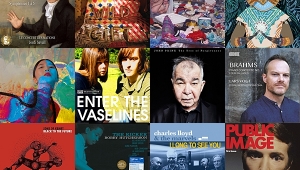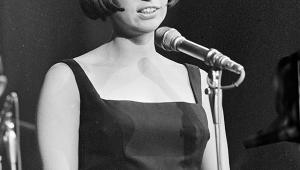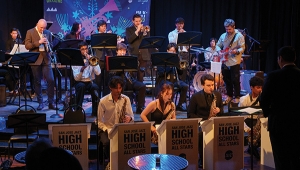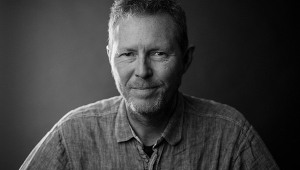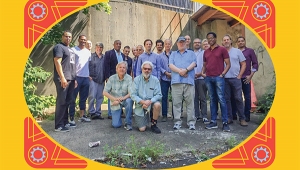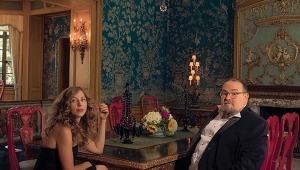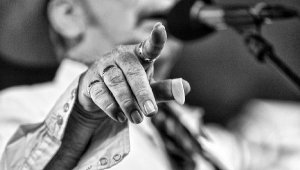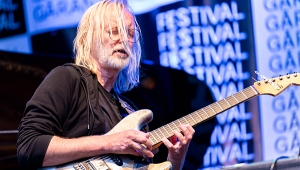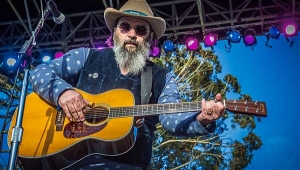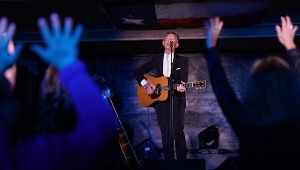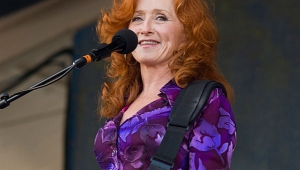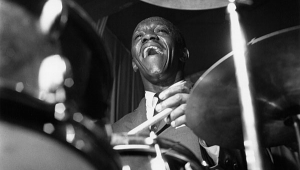| Columns Retired Columns & Blogs |
Intermezzo: The Santa Barbara Sessions Page 3
The imbalance problem solved, we now noticed a low-level rustling noise in the right channel. Jiggling the microphone leads eliminated it—though it recurred several times before we finally wrestled it into submission. After at least another hour of experimenting with microphone patterns in an attempt to obtain the lowest possible hiss (we eventually returned to the Blumlein configuration), jiggling wires, and general fiddling, we finally arrived at a point where we appeared to be ready for some real recording. While we never eliminated the mike noise to everyone's complete satisfaction, it was not (in my opinion) anything like a serious problem. At this point Kavi raised the issue of yet another possible level mismatch—one problem too many for the evening. Though it proved to be a false alarm, it was obvious that the best course of action would be to start fresh the following evening.
Footnote 4: We were, after all, still in Southern California.—TJN
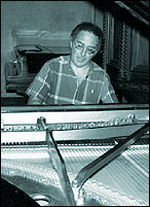 Santa Barbara has a number of bed-and-breakfast houses, and two of them hosted the Stereophile contingent. One, the restored-Victorian Simpson House, was almost directly across from the recording site, and most of us stayed there. Monday turned out to be a beautiful day, sunny and reasonably warm. Kavi wanted to show us another church that is one of his favorite recording sites (we couldn't use it for this project since it can only be reserved for a one-day session). So after breakfast Kavi, Bob Silverman, LA, and I piled into LA's rented car to visit the church and, along the way, see a bit of the local scenery. Santa Barbara and the adjoining towns are built on a narrow strip of land between the ocean and the Santa Ynez mountains, which rise rapidly to the north. The views from the suburban foothills are spectacular. A perfect spot to move the Stereophile headquarters to, I tell Larry. He grunts, no doubt reflecting on the "if you have to ask" real-estate prices.
Santa Barbara has a number of bed-and-breakfast houses, and two of them hosted the Stereophile contingent. One, the restored-Victorian Simpson House, was almost directly across from the recording site, and most of us stayed there. Monday turned out to be a beautiful day, sunny and reasonably warm. Kavi wanted to show us another church that is one of his favorite recording sites (we couldn't use it for this project since it can only be reserved for a one-day session). So after breakfast Kavi, Bob Silverman, LA, and I piled into LA's rented car to visit the church and, along the way, see a bit of the local scenery. Santa Barbara and the adjoining towns are built on a narrow strip of land between the ocean and the Santa Ynez mountains, which rise rapidly to the north. The views from the suburban foothills are spectacular. A perfect spot to move the Stereophile headquarters to, I tell Larry. He grunts, no doubt reflecting on the "if you have to ask" real-estate prices.
The church Kavi wanted to visit, the adobe-styled Our Lady of Mount Carmel, is actually located in Montecito. Kavi recorded his José Neto album there (Mountains and the Sea, Water Lily Acoustics WLA CS 02). Unfortunately, we were unable to see much of the inside; when we arrived it was filled with schoolchildren engaged in lessons of some sort. I stuck my head in briefly; it appeared to be a beautiful, mission-style structure (though built in 1936). A withering glance from the nun policing the aisle, however, reminded me of every Sunday School Sister Mary Margaret I'd ever known. I knew immediately that I'd been a bad boy, and confined the remainder of my curiosity to the vestibule and grounds—as did the rest of the group.
On the way back, Kavi had us stop at a Hindu shrine (or temple—I'm not certain of the correct designation) with one of the best views in the area. We didn't try to go inside this time, but as we stood on the steps, admiring the view and engaging in conversation, someone came out and asked if we would keep it down. This was clearly a place for meditation, not talk. It was not our day for making positive impressions at churches and shrines. On the way back, Larry dropped Bob and me at a local record store that had a reasonable selection of vinyl—a rare find these days. Kavi had advised us that the store had just gotten in a small shipment of old Decca records, and my mouth was watering. It turned out that they were American Decca (as in MCA), not English Decca (as in London), but it was worth the browse. Larry, who had driven Kavi back to the bed and breakfast, rejoined us to "do" lunch (footnote 4) at a little Italian open-air restaurant nearby that Kavi had recommended. He must not have been there in a while; they were now featuring fajitas and had restrooms marked "Caballeros" and "Women."
The remainder of the afternoon passed quickly enough, and I arrived back at the recording site around 6:30pm. After the frustrations of the night before, things were going remarkably smoothly. The piano tuner had arrived earlier and, apparently, had successfully squelched the squeak in the soft pedal. The hiss, noises, and imbalances of the previous day had been conquered. I knew it was all too good to be true when I heard a brief recurrence of that rustling noise from the night before in the right channel. But this time we knew the cause, and a slight jiggle of the mike cables silenced it. After a minor repositioning of the microphones—requested by JA to add more "hall" to the sound—and a wait to 7:00pm to minimize potential traffic noise, we were ready to begin.
I could scarcely believe it. The first take of the first movement of the Sonata went virtually without a hitch. JA was so delighted that he broke out in the first of several renditions of "Moon River" over the PA system. On later occasions he was even joined by our soloist. (We have the evidence on tape, but I suspect it will be left on the cutting-room floor.)
There were, of course, the inevitable retakes. The first run-through would have made for a superlative performance in any concert hall, but perfectionism comes with the recording territory. One technical glitch occurred which won't affect the final recording: I had become so preoccupied with my Nakamichi setup of the night before, then so wrapped up in the music during the actual sessions, that I left the Dolby off for all of the cassette recordings of the first movement! The results were a bit noisy (especially through the Stax headphones), but perfectly satisfactory for their intended use.
Footnote 4: We were, after all, still in Southern California.—TJN
- Log in or register to post comments
